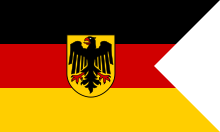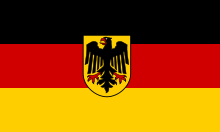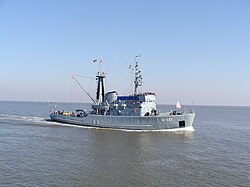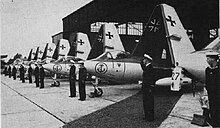Federal Navy
Until 1990, the Federal Navy was the always unofficial but generally used name for the naval forces of the Federal Republic of Germany . The official name was and is simply marine without any additions; however, since 1995 the Navy has been using the also unofficial term German Navy .
During the division of Germany (in West Germany) there was a political will to establish a clear demarcation from the People's Navy in the GDR . The term "German Navy" is from 1995 at the latest Bundeswehr no longer used, but which laid the Ministry of Defense , given the problems the official designation Navy by international standards such as within the NATO the term German Navy established when a national definition is required.
Historically, the term “ Bundesmarine” was incorrectly used for the imperial fleet of 1848. The Navy of the North German Confederation , however, was initially actually called the North German Federal Navy. In the following, the German Navy is understood to mean the Navy of the Federal Republic of Germany between 1956 and 1990.
history
German maritime associations after 1945
After the end of the Second World War , Germany was demilitarized. Under the Allied High Command, some small formations of the former Navy were still used to clear mines off the German coasts. The largest of them was the existing until 1947 German mine clearing service ( German Minesweeping Administration , GMSA). Smaller associations with customs, police and mine clearance tasks continued until 1956 and formed a human and material basis for the German Navy. The so-called Schnellbootgruppe Klose , which was previously under British leadership, was taken over as the core of a new Schnellbootwaffe.
Preliminary considerations for the German Navy
Conceptual preparatory work for a new navy had already been carried out between 1949 and 1952 in the Naval Historical Team (NHT) working for the US Navy . Shortly after the founding of the Federal Republic of Germany in 1949, Chancellor Adenauer had secret considerations made about the creation of armed forces that, with regard to the Navy, corresponded to those of the NHT. They were recorded in the Himmeroder memorandum and later supplemented again in the NHT. With a staff of 15,000 to 20,000 men, the new navy should primarily have smaller vehicles such as minesweepers , speedboats , escort boats and large torpedo boats . In addition, 24 small submarines and light naval aviation were provided. Deviating from this, the plans for the German naval component within the framework of the European Defense Community (EVG) envisaged considerably smaller forces and vehicles. Only about 11,500 active soldiers and 12,000 reservists were planned. The largest units should be escort boats, submarines and fighter planes were not provided. On the German side, these forces were rated as insufficient.
After the EVG had failed in 1954, talks about the shape of the navy began as part of the accession negotiations with NATO . The Supreme NATO Command in Europe SHAPE laid down the tasks of the Navy in a letter dated July 6, 1955 (the so-called Schuyler letter from the Chief of Staff SHAPE, US Lieutenant General Schuyler) and gave a non-binding advice on what was considered militarily necessary Scope. After that the German Navy should
- help to prevent enemy naval forces from breaking through into the North Sea through the Baltic Sea accesses or the Kiel Canal,
- stop the Soviet sea connections in the Baltic Sea as much as possible,
- take part in the Allied defense of the German Baltic coast and the Danish islands,
- contribute to maintaining the Allied sea connections in the German coastal waters and the adjacent sea areas.
Among other things, 18 small destroyers, 10 escort boats, 54 minesweepers, 40 speedboats, 12 submarines and 58 naval planes were considered necessary for this.
Development phase
On November 12, 1955, the Bundeswehr was founded as the new armed forces organization of the Federal Republic of Germany , which did not follow the traditions of the former German armed forces. The creation of the Marine armed forces was therefore a fresh start, although, as in other parts of the Bundeswehr, a large number of former members of the Wehrmacht were hired.
The establishment of the German Navy began on January 2, 1956 with a naval training company whose training was mainly provided by superiors of the Labor Service Unit (LSU), which was formerly under American supervision . The British and American navies provided extensive equipment and training assistance. On March 1, 1956, Vice Admiral Friedrich Ruge was appointed head of Department VII - Navy in the Federal Ministry of Defense . From June 1, 1957, he was named Inspector of the Navy .
On April 1, 1956, the Schnellbootlehrgeschwader was set up in Kiel under the leadership of Corvette Captain Hans-Helmut Klose . On May 2, 1956, the command of the fleet base in Wilhelmshaven-Sengwarden took up the service, on June 15, 1956 the command of the naval forces followed under the provisional leadership of Captain Max-Eckart Wolff . On May 16, 1956, the 1st Rapid Mine Search Squadron with twelve boats was put into service in Wilhelmshaven and on June 1, 1956 the 2nd Sea Mine Search Squadron with 6 boats in Bremerhaven .
As early as April 1, 1957, two minesweeping squadrons were the first to be subordinated to NATO. In the fall of 1957, the German Navy included:
- 20 Capella-class mine clearance boats (including Capella, Castor, Jupiter, Mars, Mercury, Orion, Pollux, Regulus, Rigel, Saturn, Sirius, Spica)
- 2 type 38 speedboats
- 6 speedboats of the herring gull class (ice gull, skua, herring gull, common gull, wild swan, tern)
- 6 seal class minesweepers (sea snake, sea lion, sea urchin, seal, starfish, sea horse)
- 2 submarines of class 240 (formerly class XXIII ) ( U Hai and U Hecht )
- 2 escort ships (Eider and Trave)
- 8 school boats (Nordwind, Falke, FM 1, FM 2, FM 3, UW 1, UW 2 and UW 3)
On January 17, 1958, the first US-loaned destroyer USS Anthony was taken over as Destroyer 1 .
Later construction slowed down and the structure of the navy was changed several times. The structure adopted in 1974 was essentially in place until 1990.
Conception and tasks of the Navy
The first decade

In contrast to its predecessor navies, the German Navy was designed from the outset as an alliance navy according to NATO specifications and integrated into it. Nevertheless, there were initially some conceptual ideas from the first half of the 1950s that were not coordinated with the future allies. Two essential factors had influenced these considerations: On the one hand, the strong land forces of the Eastern Bloc and the Warsaw Pact behind the so-called Iron Curtain posed a threat to the Federal Republic. On the other hand, the NATO states ruled the world's oceans as great sea powers . In this respect, the land front was the main concern in all German defense planning. Therefore, the first deliberations of the Navy aimed at the fact that a landing of superior Allied amphibious forces in the rear of the enemy, for example on the Baltic coast of the GDR , should relieve the land front. Since the major naval powers did not have enough special means to secure the Baltic Sea accesses and other tasks in the coastal apron, the German Navy should take on such tasks to prepare and secure the planned Allied landing. The Navy's first procurement program took this into account. Artillery destroyers , speedboats and minesweepers , landing craft and security troops were deployed in preparation for an amphibious operation .
The reorientation

As early as the early 1960s, it turned out that this plan was unrealistic. The military balance of power in Europe did not permit such an operation, nor did the Allies have the appropriate intentions. Rather, it became clear that the priority in the Baltic Sea had to be to repel a Soviet landing against the German and Danish coasts, which should have served to open the Baltic Sea exits for the Soviet Navy .
According to the new plans, the Federal Navy was essentially responsible for the following tasks: In the Baltic Sea, together with the Danish Navy, it was supposed to fend off landings and block the Baltic exits for Soviet warships. If possible, the Baltic Sea should be closed to all opposing maritime traffic in order to prevent reinforcement and supply of the land forces in this way. In the North Sea , the Federal Navy was supposed to make a contribution to securing its own sea routes so that Allied reinforcements could be safely transported to German, Danish and Dutch ports during the war.
Gradually, in the 1970s and 1980s, the navy received new material that was designed for these tasks. These included 40 modern missile speedboats, 24 submarines, very modern mine systems, 112 TORNADO fighter-bombers and eight frigates with helicopters. With the forces in the Baltic Sea, which made up about two-thirds of the Navy, and together with the - much smaller - Danish Navy, it was possible to build up a system of defense in the depths that would continuously allow an opposing landing force on its way through the entire Baltic Sea could have fought.
In accordance with its task, the area of operations of the German Navy initially only included the North Sea and the Baltic Sea, with the Dover - Calais line in the west and the 60th parallel to the north forming the limit for operational planning, but not for training trips. This national usage restriction was lifted in June 1980. The entire so-called northern flank area of NATO was now considered the area of operation.
The tasks that the Navy had to perform according to the plans of the Live Oak organization established in 1959 were a specialty . This organization of the three western allies was supposed to ensure the security of West Berlin through military measures. While the Allies reserved the right to operate along the transit routes in the event of a Berlin crisis , the Federal Navy was supposed to take part in measures against maritime traffic in the Warsaw Pact states in order to exert pressure on the Soviet Union.
The road to the fleet in 2005
In the mid-1980s, three developments made the naval leadership realize that further reorientation was necessary. First, soon after Mikhail Gorbachev took office in the Soviet Union , there were signs that the threat situation in Europe was beginning to change. The removal of the amphibious threat in the Baltic Sea would require a complete conversion of the Navy. Second, new conflicts emerged outside the NATO area, which would have at least an indirect influence on Germany. Already during the 1st Gulf War in 1987 the allies had moved so many ships from the Mediterranean to the Gulf region that the German Navy had to help out with an association to balance a possible power vacuum in the Mediterranean. Since then she has been present there permanently. Thirdly, it would not be possible to replace the weapons systems that were procured in large numbers from the early years one-to-one with complex modern systems. In particular, the many first generation minesweepers, which were now mainly used as mine layers, had to be sorted out and replaced by modern anti-mine vehicles .
The new considerations were already well advanced in 1990 at the time of German reunification , so that the Inspector of the Navy , Vice Admiral Hans-Joachim Mann , was able to present the fleet concept for the further development of the German Navy as early as 1991 .
organization
| year | Workforce |
|---|---|
| 1964 | 29,684 |
| 1971 | 32,135 |
| 1974 | 35,222 |
| 1976 | 34,222 |
| 1980 | 35,223 |
| 1983 | 34,939 |
| 1987 | 34,671 |
| 1991 | 30,076 |
| 1996 | 26,959 |
| 2001 | 21,801 |
structure
The Navy as the armed force of the Bundeswehr is the inspector of the navy in the Ministry of Defense conducted. He is assisted by the Navy's senior staff . The top division of the Navy has changed several times over the years. The first organization, which existed from 1956 to the end of 1960, was divided into four command areas:
- Command of the naval forces (from 1958: command of the fleet) in Wilhelmshaven
- Command of the fleet base in Wilhelmshaven
- Command of the naval training in Kiel
- Ship testing command
A first reorganization took place from the beginning of 1961 after it had been possible to improve the integration of the German Navy into the NATO command organization (for the command organization see also Fleet Command ). After that, the navy was structured as follows:
- Fleet command in Glücksburg - Meierwik
- Command of the fleet base in Wilhelmshaven
- Central naval command in Wilhelmshaven
Another change came into force in 1965, when the Central Naval Command and the Naval Base Command were combined to form the Naval Office based in Wilhelmshaven. As early as 1972 it was decided to largely reverse this change and create a new structure similar to the previous one. It came into force in 1974 and is divided into three pillars, each led by a higher command authority :
- Fleet led by the fleet command
- Naval Support Command
- Naval Office
This structure essentially lasted until 2000.
structure
Fleet command
The fleet command was responsible for the floating and flying combat units, the floating support units and facilities of the naval command services. These included (as of around 1985):
- 17 destroyers and frigates
- 5 submarines
- 60 minesweepers and other anti-mine vehicles
- 40 speedboats
- 24 submarines
- 22 landing craft
- 30 auxiliary ships
- 110 fighter-bombers
- 20 maritime patrols
- 20 light transport aircraft
- 35 helicopters
- Combat swimmers and mine divers
- Telecommunication and reconnaissance units on land
Naval Support Command
The Naval Support Command (MUKdo) was responsible for logistical support for the Navy. It supported the fleet command in establishing and maintaining the operational readiness of the fleet. The naval bases, transport forces and depots were subordinate to him.
Naval Office
The naval office was responsible for basic tasks in the areas of armaments, medical service and geophysics and the processing of personnel for teams and NCOs. Subordinate to the Naval Office were the schools of the navy, the main service of the navy (SDM) and temporarily the naval security regiment with the naval security battalions, which could also be used to a limited extent for amphibious operations .
Schools and training institutions of the Naval Office
- Naval School Mürwik in Flensburg - Mürwik
- Naval NCO school in Plön
- Marine Fernmeldeschule (MFmS) in Flensburg with basic training teaching group in Eckernförde
- Naval Coast Service School (MKüDstS) in Großenbrode with teaching group basic training in Glückstadt
- Marine locating school in Bremerhaven with a basic training group in Drangstedt
- Marine supply school (MVS) in List on Sylt
- Naval weapons school (MWaS) with teaching group A in Eckernförde and teaching group B in Kappeln / Schlei
- Technical Naval School I (TMS I) in Kiel with a ship safety teaching group in Neustadt (Holstein)
- Technical Marine School II (TMS II) in Bremerhaven with teaching group basic training in Brake / Unterweser
- Sea crew teaching group on Borkum
- Naval Aviation Training Group in Westerland on Sylt (until 1980 subordinated to the Naval Aviation Division)
deployment
The deployment of the Navy took into account the nuclear threat posed by the Cold War . Bases, air bases and other offices were spread across the entire North and Baltic Sea coasts in many locations, including larger ones from west to east:
- Borkum (base, seamanship teaching group)
- Wilhelmshaven (Marineamt, MUKdo, base, SDM, Marinetransportbataillon 2 and others)
- Brake (4th MAusBtl. 4 basic training) From 1973 (Technical Naval School, basic training group)
- Bremerhaven (Naval Locating School, Technical Naval School II)
- Nordholz near Cuxhaven (air base)
- Sylt (schools, airfield)
- Flensburg and Glücksburg ( base with schools, reconnaissance units (see Tremmerup forest settlement and the fleet command in Meierwik ))
- Schleswig (Air Base)
- Tarp (air base)
- Eckernförde (base, naval telecommunications school and naval underwater weapons school, later naval weapons school)
- Kappeln -Ellenberg (base Olpenitz , naval artillery school, later naval weapons school)
- Kiel (base, air base, naval aviation division, maritime medical institute, Baltic Sea Marine Music Corps, technical naval school I and others)
- Plön ( Naval NCO School )
- Neustadt in Holstein ( BGS See base , submarine teaching group and ship safety teaching group)
The Bundesmarine staff consisted of around 38,000 soldiers and several thousand civil servants.
Main weapon systems of the German Navy
The rearmament of Germany was subject to conditions contained in the additional protocols to the Treaty on Western European Union (WEU). Among other things, they envisaged an upper limit of the standard displacement for warships of 3,000 ts and for submarines of 350 ts as restrictions for the German Navy. The conditions were modified several times in favor of Germany and finally ceased in 1984. The last ships that were designed to comply with the WEU restrictions were the Bremen-class frigates , which were put into service between 1982 and 1990.
The initial equipment
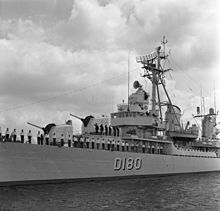
When it was set up in 1956, the Federal Navy was able to use a number of smaller vehicles with personnel from existing German sea associations such as the Maritime Border Protection , the Sea Customs and the American-led Arbeitsdienstgruppe "B" (Labor Service Unit "B" / LSU B). These were primarily guard boats and 24 mine clearance boats , most of which came from captured stocks of the navy. In addition, three speedboats of the British Baltic Fishery Protection Service (also known as Schnellbootgruppe Klose) could be taken over, which had been built from 1951 for the protection of the maritime borders, but had been taken under their own control by the Allies as unauthorized weapons of war. They too had German personnel and were led by the future commander of the fleet, Hans-Helmut Klose . Some deep-sea mine search boats of the Kriegsmarine could be bought back from French stocks . In addition, six coastal minesweepers ( Vegesack class ) were built at French shipyards for the German Navy.
The two ships Eider (A50) and Trave (A51) , two former Canadian corvettes of the newly formed training squadron Kiel of the German Navy, left for the first foreign training voyage to Den Helder ( Netherlands ), Portsmouth ( Great Britain ) and Ostend ( Belgium ) in November 1956 . Both sister ships were previously taken over by the Maritime Border Protection.
As the first submarines for the new navy, three German submarines that were sunk at the end of the Second World War were raised, completely overhauled and, for training and testing purposes, in slightly different versions as U-Hecht (S 171), U-Hai (S 170) and Wilhelm Bauer (Y 880) put into service.
The first larger ships were taken over by the British and US navies . The Royal Navy delivered some corvettes and smaller frigates, which were used as school frigates to train the new staff and were all decommissioned after less than ten years. The first six destroyers of the Federal Navy ( Fletcher-class ) and a number of dropships came from the United States .
Immediately after the reorganization, a number of new types of ships (so-called Type 55) were also ordered from German shipyards. That included
- 4 Hamburg-class destroyers
- 6 escort boats (frigates) of the Cologne class
- 18 minesweepers of the Lindau class
- 30 high speed minesweepers of the Schütze class
- 8 Ariadne class guard boats (later inland minesweepers)
- 5 torpedo fishing boats (later: submarines) of the Thetis class
- 30 Jaguar class speedboats
- 12 submarines of the class 201/205
- a greater number of tenders and auxiliary vessels.
Almost all naval aircraft in the early years were sourced abroad, with Great Britain being the main supplier. The initial equipment included (common designation in italics ):
- 68 Hawker Sea Hawk Mk.101 multi- role combat aircraft
- 16 Fairey Gannet AS.4 submarine fighters
- 4 transport aircraft Hunting-Percival Pembroke C.54
- 12 Fouga Magister CM170R trainer aircraft
- 5 Grumman HU- 16C Albatross amphibious aircraft
- 15 liaison aircraft Dornier Do 27
- 10 Bristol B171 Sycamore Mk.14 light transport helicopters
- 20 Sikorsky UH-34G rescue helicopters
The modernization of the 1960s and 1970s

It quickly became apparent that the initial equipment did not meet the requirements of modern naval warfare equipment. On the one hand, it was out of date material, some of which still came from the Second World War; on the other hand, the first conceptual considerations of the naval command, on which the initial procurement planning had been based, turned out to be unrealistic (see above Concept and tasks of the navy ). In addition, as early as the late 1950s, Soviet naval armaments had made significant advances in the development of anti-ship missiles , thus creating a threat that was far superior to that of the German navy. Finally, it had also become apparent that the German shipbuilding industry had lost touch with modern naval armaments during the post-war period and was only capable of building complex weapon systems to a limited extent. Missile destroyers were therefore procured from the USA , speedboats with anti-ship missiles from France and frigate designs from the Netherlands .
At the same time, the new building programs that had been started were continued, even if not always to the extent originally planned. The class 201 submarines had major problems with structural steel and the first boats were converted to class 205 , and the procurement of the more powerful class 206 was initiated.
The main ship purchases of this time were:
- 3 missile destroyers of class 103 (Lütjens class)
- 18 class 206 submarines
- 10 Sable-class torpedo speedboats
- 20 Tiger-class missile speedboats
- 10 missile speedboats of the Albatros class
- 10 inland minesweepers of the Frauenlob class
- 8 suppliers of the Lüneburg class
The fleet of aircraft in the Navy was almost completely replaced. The following were procured:
- 127 Lockheed F-104 G Starfighter fighter-bombers , including 1 squadron of reconnaissance aircraft
- 20 maritime patrol aircraft Bréguet 1150 Atlantic , 5 of them for electronic reconnaissance
- 22 sea rescue helicopters (later also combat and transport helicopters) Westland SeaKing Mk 41
- 20 Dornier Do 28 D-2 Skyservant transport and liaison aircraft
There were also significant innovations in the equipment. These included a number of missile systems (ship-to-ship; ship-to-air; air-to-ship), wire-guided torpedoes for submarines and speedboats, and modern command systems including the Link 11 data exchange system . With these new systems, the German Navy - and with it German industry - got access to modern armament technology. In some areas, particularly in the area of coastal warfare , it even achieved a leading position.
"The third generation"
Modernization continued in the 1980s, with the priority now being to replace the first post-war buildings. It was clear that the very simple systems built in large numbers could not be replaced piece by piece with technically complex new buildings.
The new buildings of this period include:
- 8 Bremen-class frigates
- 10 Gepard- class missile speedboats
- 10 Hameln-class mine attack boats
- 3 fleet service boats ( reconnaissance ships ) of the Oste class
In addition, the Lindau-class coastal minesweepers were modernized. 12 boats were converted into mine-hunting boats and 6 boats into guide boats for the Troika remote clearing system . In addition, there were modern sea mines to ward off enemy landings.
The following new aircraft were introduced:
- 112 Panavia Tornado multi-role fighter aircraft
- 12 (more later) on- board helicopters Westland "Sea Lynx" Mk 88
With the modern frigates and their on-board helicopters, the German Navy succeeded in reaching the technical level of the larger western navy even with the larger warships. The tornadoes brought a significant increase in combat power and range compared to the starfighter . The ships, boats and airplanes received considerably more extensive electronic equipment, some of which were also retrofitted on older vehicles. At the end of the 1980s the navy procured equipment that was optimized for its main tasks in the North and Baltic Seas.
Telecommunication organization
The German Navy also had its own telecommunications system with a coastal radar organization and a strong electronic reconnaissance component . These forces were under the naval command service command.
The most important transmission systems were:
- Rhauderfehn marine radio station in Saterland
- Glücksburg marine radio station in Glücksburg
- Naval radio station Neuharlingersiel in Neuharlingersiel
Balance sheet
After the first conceptual approaches for a German naval contribution to the alliance had not proven to be realistic, from the 1970s onwards it was possible to build a powerful navy that was taken very seriously by possible opponents in the Baltic Sea.
The Soviet Union had to realize that its Baltic fleet would not be able to operate in the North Atlantic . That is why the large ships and many submarines were stationed in the North Sea (see Northern Fleet ). A new infrastructure had to be created there, far from the industrial centers of Russia. The climatic conditions put an extraordinary strain on people and material. In the Baltic Sea, the submarine threat, which was directed against supplies for the land forces as well as landing units, was viewed as very serious. The 30 western submarines (24 German and six Danish) with a total of less than 1,000 men were opposed by 75 anti-submarine ships and 150 special aircraft and helicopters with around 15,000 men. The concept of the German Navy has thus proven to be very efficient.
1989–1990 ended the confrontation between West and East, in the scenario of which the German Navy had its firm place. However, even before the reunification on October 3, 1990, she was confronted with the new tasks that the armed forces had to face. On August 16, 1990, the mine defense association for Operation South Flank was the first of the new foreign missions of the Bundeswehr in the Mediterranean. With the changes that have occurred since 1990, the German Navy has been given new tasks.
See also
- History of the German Navy
- History of the Bundeswehr
- List of ships of the Bundeswehr
- List of associations and offices of the German Navy
literature
- Johannes Berthold Sander-Nagashima: The Federal Navy 1955 to 1972: Concept and construction. Oldenbourg, Munich 2006, ISBN 978-3-486-57972-7 .
- Günter Kroschel, Klaus-Jürgen Steindorf: The German Navy 1955–1985 - Ships and Airplanes. Lohse-Eissing, Wilhelmshaven 1985, ISBN 3-920602-30-7 .
- Pete Dine: German Navy. Bernard & Graefe Verlag, Munich 1980, ISBN 978-3-8033-0307-3 .
- Douglas Carl Pfeifer: Establishing the Bundesmarine: The Convergence of Central Planning and Pre-existing Maritime Organizations, 1950–1956. In: James S. Corum (ed.): Rearming Germany. Leiden / Boston (Brill) 2011, ISBN 978-90-04-20317-4 , pp. 117-141.
Web links
- History - The Federal Navy on the website of the Navy
Individual evidence
- ↑ www.marine.de , accessed on June 20, 2019.
- ↑ According to a letter from the Federal Ministry of Defense from 1956 (Press and Information Center Navy).
- ↑ Press and Information Center Navy: German Navy - Press release: “Federal Navy” or “German Navy”? - What is the correct name of the smallest branch of the Bundeswehr? Presseportal.de, April 30, 2009, accessed March 3, 2015.
- ^ Karl-Adolf Zenker : From the prehistory of the Federal Navy. In: German Marine Institute , German Marine Academy (Hrsg.): The German Navy. Historical self-image and position determination. (= Series of publications. Volume 4). Herford / Bonn 1983, ISBN 3-8132-0157-0 , p. 91 ff.
- ↑ See also Jörg Duppler: Continuity and discontinuity in the self-image of the Navy. In: Marineforum 4-1996 ,. P. 2 ff.
- ^ The Role of the United States Navy in the Formation and Development of the Federal German Navy, 1945-1970. Archived from the original on December 9, 2013 ; accessed on December 17, 2019 .
- ^ Military History Research Office ( Memento of January 8, 2007 in the Internet Archive )
- ↑ Sigurd Hess: In the best shooting position.
- ^ Konrad Ehrensberger: 100 years of organization of the German navy. Bonn 1993, ISBN 3-7637-5913-1 .
